Physical Address
304 North Cardinal St.
Dorchester Center, MA 02124
Vasculitis is a histologic diagnosis defined as inflammatory cell infiltration and destruction of blood vessels. Vasculitis is generally classified as primary vasculitis (idiopathic e.g., cutaneous leukocytoclastic angiitis [CLA], granulomatosis with polyangiitis [GPA]); secondary vasculitis (a manifestation of connective tissue diseases [CTDs], infections, adverse drug eruptions, or a paraneoplastic phenomenon); or incidental vasculitis, a histologic finding that is the consequence of another pathologic process such as traumatic ulceration or diffuse neutrophilic infiltrates. Clinically, cutaneous vasculitis can present in a panoply of morphologies that include urticaria, purpura, hemorrhagic vesicles, ulcers, nodules, livedo, infarcts, and digital gangrene. These findings may represent the cutaneous manifestation of systemic disease, or, as is the case in most instances, represent a benign self-limited, single-episode phenomenon.
The diagnosis of vasculitis syndromes is problematic. Specific clinical vasculitic entities do not always correlate exactly with mechanisms, and any patient with vasculitis may have a constellation of morphologic signs that overlaps with another clinical entity that prevents confident clinical diagnosis. Currently, the most widely adopted vasculitis classification system is that of Chapel Hill Consensus conference (CHCC), which is based on pathologic criteria. The other widely used system is that of the American College of Rheumatology (ACR), which is based predominantly on clinical findings. However, neither system is problem free. Both of these classification criteria were not originally developed as diagnostic criteria for individual patients (particularly those with early disease) but for comparisons of groups of patients. When CHCC or ACR criteria are applied to individual patients, shortcomings are apparent with a lack of recognition of specific disorders and overlap among primary vasculitides. For example, systemic polyarteritis nodosa (PAN) is a rare, if not nonexistent, disease by CHCC criteria but is relatively common by ACR criteria, and patients diagnosed with hypersensitivity vasculitis by ACR criteria can also be classified as Henoch-Schönlein purpura (HSP). These latter patients, particularly if systemic disease is present, can also be classified as having microscopic polyangiitis (MPA) by CHCC criteria.
A definitive diagnosis of vasculitis requires histologic confirmation in almost all cases because few vasculitic syndromes have pathognomonic clinical, radiographic, and/or laboratory findings. Nonetheless, a biopsy diagnosis of vasculitis cannot stand by itself, as it must be correlated with clinical history, physical and laboratory findings and/or angiographic features. For example, a diagnosis of vasculitis restricted to the skin (also known as hypersensitivity vasculitis, CLA, or leukocytoclastic vasculitis) requires that the systemic manifestations of vasculitis be sought and found absent. If systemic vasculitis is present, imaging studies can provide a useful means to determine disease extension and activity, and serology, such as C-reactive protein (CRP) and antineutrophilic cytoplasmic antibodies (ANCA) levels and type, can be used to monitor disease activity and predict mortality risk, respectively. Therefore, the classification of cutaneous vasculitis into specific syndromes is best approached morphologically by determining vessel size and principal inflammatory response. These histologic patterns roughly correlate with pathogenic mechanisms that, when coupled with direct immunofluorescence (DIF) examination, ANCA status, and findings from workup for systemic disease, allows for specific diagnosis, and ultimately, more effective therapy ( Fig. 4-1 and Table 4-1 ). In the evaluation of cutaneous vasculitis, accurate histologic classification is the first step in arriving in reproducible diagnosis of specific vasculitic syndrome.
| Small Vessel Vasculitis |
|---|
| Neutrophilic |
| Immune-complex mediated (DIF+) |
| CLA (also known as hypersensitivity vasculitis and LCV) |
| Henoch-Schönlein purpura |
| Acute infantile hemorrhagic edema |
| Urticarial vasculitis |
| Chronic localized fibrosing vasculitis: EED, granuloma faciale, inflammatory pseudotumors |
| Incidental vasculitis (DIF−) |
| Sweet's syndrome and pustular vasculitis of the dorsa of the hands |
| Eosinophilic |
| Eosinophilic vasculitis, primary or secondary to connective tissue disease, or parasites |
| Some cases of EGPA |
| Granulomatous |
| Postherpetic eruptions |
| Necrobiosis lipoidica (some lesions) |
| Lymphocytic |
| Rickettsial and viral infections |
| Lichenoid dermatitides, some cases (e.g., pityriasis lichenoides, GVHD, perniosis) |
| T-cell lymphomas: angiocentric T-cell lymphoma, lymphomatoid papulosis, mycosis fungoides |
| Rare drug reactions and arthropod assaults |
| Mixed, Predominantly Small and Medium Vessel Vasculitis |
| Neutrophilic |
| Immune complex mediated (DIF+) |
| Cryoglobulinemic vasculitis |
| Hypocomplementemic urticarial vasculitis syndrome |
| CTD vasculitis (e.g., lupus, rheumatoid arthritis, Sjögren's syndrome) |
| ANCA-associated or pauci-immune (DIF−) |
| Granulomatosis with polyangiitis |
| Microscopic polyangiitis (microscopic polyarteritis nodosa) |
| EGPA |
| Drug-induced ANCA vasculitis |
| Miscellaneous or other |
| Behçet's disease |
| Septic vasculitis |
| Lymphocytic |
| Degos' disease |
| Rickettsial and viral infections |
| Collagen tissue disease vasculitis (e.g., Sjögren's syndrome, lupus vasculitis) |
| Behçet's disease |
| Medium (to Large) Muscular Vessel Vasculitis |
| Neutrophilic |
| Polyarteritis nodosa, classic and cutaneous |
| Nodular vasculitis (erythema induratum) |
| Eosinophilic |
| Juvenile temporal arteritis |
| Granulomatous |
| Giant cell (temporal) arteritis |
| Takayasu's arteritis |
| Postherpetic eruptions |
| Lymphocytic |
| Sneddon's syndrome |
| Degos' disease |
| Beurger's disease (thromboangiitis obliterans) |
| Superficial thrombophlebitis (Mondor's disease, sclerosing lymphangiitis) |
| Kawasaki's disease |
Cutaneous vasculitis affects all ages, with slight female predominance, and adults more often than children, 90% of the latter who will have HSP (IgA vasculitis). In adults, the mean age of onset of vasculitis is 47 years, and among children, the mean age of onset is 7 years. The onset of vasculitis after exposure to a trigger such as a drug or infection is 7 to 10 days. A mean interval of 6 months (range, weeks to years) exists between the onset of symptoms and signs of systemic disease and the onset of secondary cutaneous vasculitis. Three patterns of disease evolution occur in cutaneous vasculitis: (1) single acute, self-limited episode (resolves in ≤6 months) of vasculitis typically associated with a drug or infectious trigger (~60% of all cases); (2) relapsing disease with symptom-free periods usually found in patients with HSP and CTD associated vasculitis (~20%); and (3) a chronic, unremitting disease often associated with cryoglobulinemia and malignancy (~20%). The duration of vasculitis can range from 1 week to 318 months, with mean and median durations of 28 months and 3.7 months, respectively. Fewer than 20% of patients with cutaneous vasculitis will have extracutaneous (visceral) vasculitis. Fatal disease occurs in a minority of patients (<7%).
In general, systemic symptoms accompany all cutaneous vasculitic syndromes, and these symptoms include fever, malaise, weight loss, arthritis, and arthralgias. In the majority of patients, vasculitic lesions affect the lower extremities. Upper extremity, trunk, and head and neck involvement are infrequent and often signal the presence of more severe disease or coexisting systemic vasculitis.
An understanding of the skin's vascular anatomy helps in characterizing the cutaneous manifestation of vasculitis. The skin receives its blood supply from penetrating vessels from within the underlying subcutaneous fat, which contains medium-sized vessels. These medium-sized vessels branch out to give rise to two vascular plexuses that are intercommunicating with each other: the deep vascular plexus lying at the interface between the dermis and subcutaneous fat and the superficial plexus located in the superficial aspects of the reticular dermis, which further on supplies the papillary dermis by forming capillary loops. These loops are composed of terminal arteriole, capillaries (arterial and venous), and postcapillary venules.
The type of cutaneous lesion closely correlates with the size of the vessel affected by vasculitis ( Table 4-2 ). Sparse superficial perivascular neutrophilic infiltrates associated with nuclear debris and extravasated red blood cells (RBCs) result in urticarial papules and plaques ( Fig. 4-2 ), which last longer than 24 hours, burn rather than itch, and resolve with residual pigmentation. Small, predominantly superficial vessel involvement results in purpuric macules ( Fig. 4-3 ) and infiltrated erythema, but deeper dermal small vessel vasculitis correlates with palpable purpura or vesiculobullous lesions.
| Large | Medium | Small |
|---|---|---|
| Limb claudication | Subcutaneous nodules | Purpura |
| Asymmetric blood pressure | Ulcers | Urticaria |
| Absence of pulses | Livedo reticularis | Vesiculobullous lesions |
| Aortic dilation | Pitted palmar or digital scars | Splinter hemorrhages |
| Bruits | Digital gangrene | Scleritis, episcleritis, uveitis |
| Mononeuritis | Palisaded neutrophilic granulomatous dermatitis * | |
| Aneurysms | Glomerulonephritis | |
| Infarct | Gastric colic | |
| Hypertension (renal artery) | Pulmonary hemorrhage | |
| Constitutional symptoms: fever, weight loss, malaise, arthralgias, and arthritis are common to vasculitic syndromes of all vessel sizes | ||
* Also called extravascular necrotizing granuloma. Small vessel neutrophilic vasculitis is frequently seen in the vicinity of granulomas and necrosis.
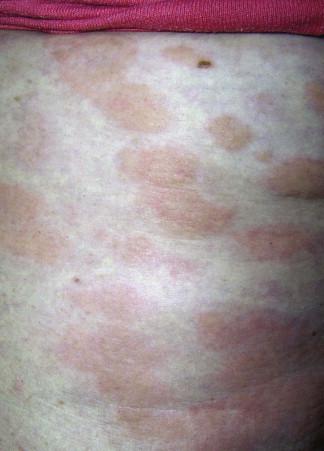
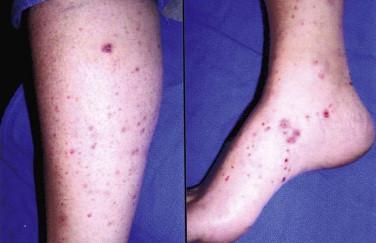
In cutaneous leukocytoclastic vasculitis, immune complexes deposit, and inflammation mainly targeting the postcapillary venules give rise to the clinical picture of small palpable purpura. If the inflammation targets arterioles and arteries, because these vessels supply multiple dermal papillae, it this will result in large purpuric lesions with irregular borders. Ulcers, nodules, pitted scars, and livedo reticularis are associated with arterial muscular vessel involvement, which is located at the dermal-subcutis interface or within the subcutis.
The choice of clinical lesions and type of pathologic assessment have great impact on the diagnostic yield of cutaneous biopsies. First, the optimal time for skin biopsy is 24 to 48 hours after the appearance of a vasculitic lesion. If the biopsy is poorly timed, the pathologic features of vasculitis may be absent, a fact that clinicians must bear in mind when interpreting a negative biopsy finding from a patient whose clinical findings suggest vasculitis. A punch biopsy of a lesion at the appropriate stage will enable histologic confirmation of most small vessel vasculitic syndromes. Purpuric lesions obtained in the first 24 hours are characterized by fibrin deposits within the vessel wall accompanied by neutrophilic infiltration of the wall and surrounding hemorrhage and nuclear debris. After 24 hours, neutrophils are replaced by lymphocytes and macrophages. Biopsy of lesions more than 48 hours old, regardless of the underlying form of vasculitis, may show lymphocyte-rich infiltrates. Second, the choice of a shave biopsy, punch biopsy, or excisional biopsy affects which vessels are examined because the type of vessel depends on the location within the skin and subcutis (i.e., the deeper the location, the larger the vessel). Thus, if a medium-vessel vasculitis such as PAN is suspected, the biopsy must include the subcutaneous fat where medium-sized vessels are situated. Incisional biopsy is required for cases affecting larger vessels (nodular vasculitis and giant cell arteritis [GCA]) (see Fig. 4-1 ). In the case of livedo reticularis, a deep biopsy extending to the subcutis should be taken from the center of the circular livedo segment (the white center, not the red periphery) because this is where the stenosed vessel responsible for the cyanotic periphery is located. Third, biopsies should be obtained from nonulcerated sites, or if not possible, from the edge of an ulcer. Last, omission of a biopsy for DIF studies wastes an opportunity to collect potentially valuable information and often leads to misdiagnosis. It is best to take two biopsies, one for light microscopy and one for DIF examination, rather than split one specimen. In fact, multiple biopsies and extending the biopsy depth to the subcutis and fascia can significantly increase the diagnostic yield for vasculitis.
The diagnosis of cutaneous vasculitis of medium or small vessels is made primarily by biopsies and examination of hematoxylin and eosin (H&E)–stained sections. Table 4-3 lists criteria for diagnosis of cutaneous vasculitis. Fibrinoid necrosis (fibrin deposition within and around the vessel wall) is a common histologic feature of nearly all early vasculitic lesions and is caused by the accumulation of plasma proteins, including coagulation factors that are converted to fibrin, at sites of vessel wall destruction ( Figs. 4-4 and 4-5 ). The diagnosis of vasculitis can be unequivocally be made if there are inflammatory infiltrates within and around the walls of vessels accompanied by fibrin deposition. These changes commonly coexist with signs of endothelial damage in the form of endothelial swelling, shrinkage (apoptosis), or sloughing. Secondary changes in which vascular damage can be inferred are the histologic findings of extravasation of RBCs (purpura), necrosis (infarct), and ulceration secondary to the ischemia from vessel obstruction or destruction by the inflammatory insult. The type of inflammatory cell mediating vessel damage and vessel sizes affected roughly correlate with pathogenic mechanisms, which are listed in Table 4-4 .
| Histologic Signs of Acute (Active) Vasculitis |
|---|
| Dermal small vessels (venules and arterioles) (two of three * criteria needed) |
| Angiocentric † or angioinvasive inflammatory infiltrates * |
| Disruption or destruction of vessel wall by inflammatory infiltrate * |
| Intramural or intraluminal fibrin deposition (“fibrinoid necrosis”) * |
| Dermal-subcutaneous muscular vessels (small arteries and veins) |
| Infiltration of muscular vessel wall by inflammatory cells * |
| Intramural and/or intraluminal fibrin deposition (“fibrinoid necrosis”) * § |
| Secondary changes of active vasculitis (suggestive, but not diagnostic, of vasculitis) † |
| RBC extravasation (petechiae, purpura, hematoma) |
| Nuclear dust, perivascular (leukocytoclasia) |
| Endothelial swelling, sloughing, or necrosis |
| Eccrine gland necrosis (or regeneration with basal cell hyperplasia) |
| Ulceration |
| Necrosis or infarction |
| Histologic Sequelae of Vasculitis (Chronic Signs and Healed Lesions of Vasculitis) |
| Lamination (onion-skinning) of vessel wall constituents † (concentric proliferation of pericytes and smooth muscle cells) |
| Luminal obliteration (endarteritis obliterans) † Intimal or medial proliferation of cellular elements leading to luminal occlusion with preservation of the internal elastic lamina |
| Segmental or complete loss of elastic lamina in medium and large vessels associated with acellular scar tissue * |
| Reactive angioendotheliomatosis |
| Neovascularization of vessel adventitia |
* Required for diagnosis of vasculitis.
† Other types of vessel injury can cause same pattern.
§ : intraluminal fibrin deposition can be found in non-vasculitic arterial lesions such as malignant hypertension and anti-phospholipid antibody syndrome.
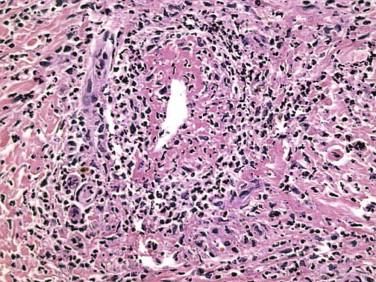
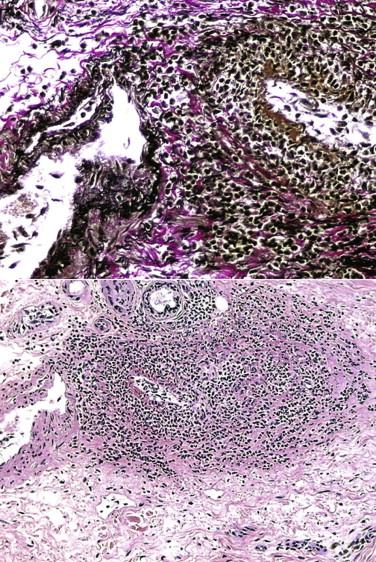
| Pathogenic Mechanism | Vasculitic Syndrome | Vasculitis Pattern |
|---|---|---|
| Direct infection | Rickettsial infections | Lymphocytic small vessel vasculitis |
| Type I anaphylactic | Eosinophilic vasculitis Eosinophilic granulomatosis with polyangiitis |
Eosinophilic small vessel vasculitis Eosinophilic small and medium vessel vasculitis * |
| Type II cytotoxic–cytolytic antibody | Granulomatosis with polyangiitis Microscopic polyangiitis |
Neutrophilic mostly small and medium vessel vasculitis Neutrophilic mostly small and medium vessel vasculitis |
| Type III immune complex | Henoch-Schönlein purpura Cutaneous leukocytoclastic angiitis Cryoglobulinemic vasculitis Polyarteritis nodosa |
Neutrophilic small vessel vasculitis Neutrophilic small vessel vasculitis Neutrophilic mostly small and medium vessel vasculitis Neutrophilic medium vessel vasculitis |
| Type IV delayed hypersensitivity | Giant cell arteritis Chronic graft versus host disease Sneddon's syndrome; Degos' disease |
Granulomatous medium vessel vasculitis Lymphocytic small vessel vasculitis Lymphocytic medium vessel vasculitis followed by endarteritis obliterans |
Circumstantial evidence of vessel wall damage, thus vasculitis, includes lamination of the adventitia, media, or intima of vessels (so-called onion skinning); perivascular nuclear dust (leukocytoclasia) without fibrin deposits (early, evolving leukocytoclastic vasculitis (LCV)); sharply defined loss of the elastic lamina associated with acellular scar tissue (the healed stage of muscular vessel vasculitis); or in the case of muscular (large) vessels, subendothelial, intramuscular, or adventitial inflammatory cells. In addition, neovascularization of the adventitia, formation of small capillaries, is a prominent feature of mature and older lesions of medium vessel vasculitis such as PAN and GCA and a component of chronic localized small vessel vasculitis such as erythema elevatum diutinum (EED). Last, luminal obliteration (endarteritis obliterans) is an irreversible, ischemic consequence of some forms of vasculitis such as lymphocytic and granulomatous arteritis. Endarteritis obliterans typically affects small- to medium-sized arteries. Healed lesions of muscular vessel vasculitis, the acellular scar stage, do not progress to endarteritis obliterans and can be associated with either luminal stenosis or aneurysm formation; however, persistence of vessel wall inflammation, either medial or intimal, can eventually lead to luminal obliteration or aneurysm rupture. Endarteritis obliterans can be broken down in stages. Initially, a lymphocytic endothelialitis (endarteritis) is evident that is followed by the formation of a sponge-like plug composed of mononuclear cells, fibrin, and RBCs that results in partial to complete obstruction. A perivascular lymphohistiocytic (non-neutrophilic) inflammatory infiltrate develops around affected arteries, which is then followed by formation of dilated capillaries in obstructed vessels' adventitia. Smooth muscle cells immigrate and proliferate in the subendothelial zone, organizing the occluding plug during the intermediate stage. The final stage is characterized by fibrosis, shrinkage, and atrophy of the occluded artery.
It is common to find changes of neutrophilic small vessel vasculitis underlying an ulcer formed by another process (trauma or surgery). This is incidental vascular injury and can usually be differentiated from primary vasculitis by correlation with history and the focal nature of the vessel damage that is restricted to the area of trauma or ulceration; the vessels in the surrounding skin will be unaffected. (The term secondary vasculitis is not used because it refers to vasculitis developing secondarily in systemic disease, e.g., rheumatoid or lupus vasculitis). Neutrophilic dermatoses (e.g. Sweet's syndrome) can also exhibit neutrophil-mediated vessel damage that can resemble small vessel neutrophilic vasculitis in approximately one third of cases, typically affecting vessels within the diffuse dermal neutrophilic infiltrate compared with the angiocentric neutrophilic infiltrate of LCV.
Some cutaneous vasculitis patients with systemic disease exhibit histologic findings concomitant to the vasculitis that will point to etiology and or diagnosis, such as granulomatous dermatitis, dermal eosinophilia, or dermal neutrophilia ( Table 4-5 ). Angiocentric fibrosis associated with foci of leukocytoclasis can be seen in some cases of cutaneous inflammatory pseudotumor and mature lesions of EED and granuloma faciale ( Fig. 4-6 ). Eosinophilic or “red” extravascular granulomas (palisaded neutrophilic granulomatous dermatitis with eosinophils) are found in the papular and nodular extremity lesions of eosinophilic granulomatosis with polyangiitis (EGPA). “Blue” extravascular granulomas (palisaded neutrophilic granulomatous dermatitis) are found in some papular and nodular lesions in rheumatoid vasculitis (RV) and GPA. Sub- and intraepidermal pustules are seen in this case of cutaneous vasculitis triggered by bacterial pharyngitis as well as in septic vasculitis.
| Lamellar or storiform fibrosis |
| Erythema elevatum diutinum, granuloma faciale, or inflammatory pseudotumor |
| Diffuse (sparse) dermal granulocytic infiltrates |
| Tissue neutrophilia: urticarial vasculitis associated with systemic lupus erythematosus |
| Tissue eosinophilia: eosinophilic granulomatosis with polyangiitis, hypereosinophilic syndrome with vasculitis |
| Palisaded and neutrophilic granulomatous dermatitis * |
| “Red” extravascular granuloma (eosinophils, flame figures): eosinophilic granulomatosis with polyangiitis, granulomatosis with polyangiitis (rare) |
| “Blue” extravascular granuloma (neutrophils, nuclear dust): granulomatosis with polyangiitis, rheumatoid vasculitis |
| Eosinophilic granulomatosis with polyangiitis (rarely) |
| Vacuolar interface dermatitis (sometimes dermal mucin deposition) |
| Connective tissue diseases: lupus erythematosus, dermatomyositis |
| “Pustular” dermatosis with intraepidermal or subepidermal neutrophilic abscesses |
| Infectious trigger, septic vasculitis |
* Also known as Winklemann's granuloma, Churg-Strauss granuloma, extravascular necrotizing granuloma, and rheumatoid papules.
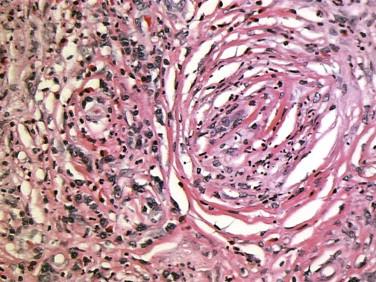
The absence of immune complexes, so-called pauci-immune vasculitis, is the expected finding in GPA, EGPA, and MPA with or without medium-sized vessel involvement. Deposition of IgG, IgM, IgA, or C3 in or around the vessels characterizes immune complex–mediated vasculitis such as cryoglobulinemic vasculitis (CV) and most cases of CLA. The most common immunoreactant found in vessels by DIF is C3 followed by IgM, IgA, and IgG ( Fig. 4-7 ). Fibrinogen vascular deposits are also commonly found. Similar to H&E evaluation, the presence of diagnostic immunofluorescence patterns is inversely related to the age of the lesion biopsied. One hundred percent of biopsies will harbor immunoglobulins within the first 48 hours; 30% will be negative at 48 to 72 hours; and after 72 hours, only C3 is detected in positive DIF samples. In addition, the type of immunoglobulin and pattern of deposits in DIF exams can add diagnostic value: predominant IgA vascular deposits are found in HSP and point towards renal involvement; and basement membrane zone or keratinocyte nuclear (in vivo antinuclear antibodies [ANA]) immunoreactants, mostly IgG, can be found in CTD vasculitis such as lupus vasculitis. In the evaluation of urticarial vasculitis (UV), the finding of basement membrane zone fluorescence may be seen in patients with hypocomplementemic states and who have CTD. In addition, IgM deposition in blood vessels may be readily seen in cases of vasculitis with a circulating rheumatoid factor (RF) or with monoclonal production of IgM as found in CV.
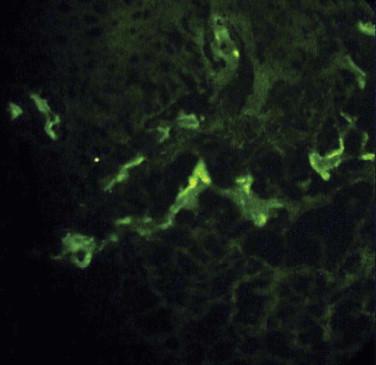
Active vasculitis is typically associated with an acute phase response with an increase in CRP, erythrocyte sedimentation rate (ESR), and plasma viscosity. Other serologic tests useful in the work up of vasculitis patient are tests for RF, ANA, anti-dsDNA antibodies, antiprecipitin antibodies (Ro, La, RNP, and Sm), CH50, C3 and C4 levels, cryoglobulins, and ANCAs, as well as performing a chest radiography and serum and urine electrophoresis. In addition, monitoring of levels of certain cytokines (interleukin-6 [IL-6], tumor necrosis factor α [TNF-α]), cANCA, acute phase reactants (e.g. CRP), activated coagulation markers (thrombin–antithrombin III complexes), or markers of endothelial function (endothelial microparticles, thrombomodulin) can potentially measure disease activity and response to therapy.
ANCA testing has been established as a useful tool for the diagnosis of small vessel vasculitides. ANCA-associated vasculitides include GPA, MPA, EGPA, and some drug-related vasculitis, but ANCA can be also found in patients with inflammatory bowel disease, CTD, and other chronic inflammatory diseases, some of whom may have vasculitis. Positive ANCA patterns should be separated into pANCA and cANCA. The perinuclear pattern of ANCA, p-ANCA, may be seen with myeloperoxidase (MPO) antibodies as well as others (e.g., lactoferrin, cathepsin) and is found in MPA and EGPA. The cytoplasmic pattern of ANCA, c-ANCA, is mostly anti-proteinase 3 (anti-PR3), which is strongly associated with GPA. However, the presence of ANCA is not diagnostic of systemic vasculitis because up to 60% of patients with cutaneous LCV can have a positive ANCA result and disease limited to their skin, and ANCA is found at low levels in many systemic inflammatory and pulmonary disorders that mimic vasculitis. In this latter group, atypical indirect immunofluorescent patterns are present, and antibodies to PR-3 and MPO are rare by antigen specific enzyme-linked immunosorbent assay (ELISA) testing.
If cutaneous vasculitis is documented pathologically, then the clinician must establish the exact diagnosis by evaluating for the presence and extent of systemic disease, identifying any treatable etiology such as drug, infection, malignancy, or coexisting systemic disease, and treating this condition. These steps will include a careful clinical history determining whether this is an acute or chronic condition and searching for triggers such as drugs or infections or symptoms indicative pre-existing or concomitant disease, physical examination, chest radiography and routine laboratory tests (blood and urine). If specific symptoms or signs of systemic disease, such as mononeuritis or microhematuria, are evident, further studies should be considered to arrive at specific diagnosis of a primary systemic vasculitis (PSV) or secondary systemic vasculitis. Symptoms indicating systemic involvement include arthralgias, myalgias, fever, hemoptysis, shortness of breath, cough, wheezing, eye or ear symptoms, sinusitis, hoarseness, numbness or paresthesias, abdominal pain, melena, hematuria, and testicular pain. Questioning for the presence of night sweats and weight loss or complaints of dry eyes or mouth, photosensitivity or facial cutaneous eruption, oral lesions, or muscle weakness will help to determine if the vasculitis is associated with malignancy or CTD. Clinical examination helps to determine the size of vessel involvement, which can narrow the differential diagnosis (see Table 4-2 ). For patients suspected of having chronic or systemic vasculitis, the following laboratory studies are recommended: complete blood cell count with differential, blood urea nitrogen or creatinine, liver function panel, urinalysis, stool guaiac, hepatitis B and C virus serologies, cryoglobulins, precipitins, complement levels (CH50, C3, C4), ANCA, ANA, and RF. Additional tests to consider are blood cultures and echocardiography if the patient has a high fever or a heart murmur and antistreptolysin O titers in children. Although most cases of cutaneous vasculitis are benign and self-limited, a significant minority of cutaneous vasculitis patients will has extracutaneous disease, frequently renal involvement; contrarily, cutaneous disease occurs in up to 50% of PSV patients, and it can be the first presenting sign of disease in up to a quarter of patients with EGPA. Table 4-6 lists the clinical, pathologic, and laboratory findings that signal a high probability of systemic vasculitis or coexisting systemic disease. Table 4-7 lists the mean frequencies of cutaneous, laboratory, and systemic findings for the major vasculitic syndromes affecting the skin. Based on these observations, which demonstrate broad overlap among many specific vasculitic syndromes, vasculitis can be considered a systemic disease that can present with predominant cutaneous involvement irrespective of whether clinical evidence exists of visceral involvement. After cutaneous vasculitis is documented pathologically, then the clinician must correlate clinical and laboratory data to arrive at a specific diagnosis.
| Findings | Suspected Systemic Vasculitis Syndrome |
|---|---|
| Clinical signs or symptoms | |
| High fever | Infection, systemic inflammatory disorders |
| Paresthesias, foot drop | EGPA, PAN |
| Abdominal pain | HSP, EGPA |
| Frank arthritis | RV, infection, PAN, systemic inflammatory disorder |
| Hypertension | PAN |
| Purpura above waist, upper extremities | HSP, MPA, GPA, EGPA |
| >One type of vasculitic lesion * | HSP, MPA, GPA, EGPA |
| Punctuate palmar lesions | LV |
| Laboratory evaluation | |
| ESR >40 mm/hr | Infection, hematologic malignancies, systemic inflammatory disorders |
| Elevated RF and cryoglobulins and low complement | CV |
| Chest radiograph: infiltrates or cavities | GPA, EGPA, MPA, malignancy |
| Hematuria or proteinuria or abnormal creatinine | Dermal-renal vasculitis syndrome: GPA, MPA, HSP, SLE |
| Hypocomplementemia | UV associated with SLE |
| Abnormal blood count | Infection, hematologic malignancy, systemic inflammatory disorders |
| cANCA (PR3) | GPA |
| pANCA (MPO) | MPA, EGPA |
| Histologic examination | |
| Deep dermal and/or subcutaneous small and/or muscular vessel vasculitis | Systemic vasculitis syndrome (GPA, EGPA, MPA, CV, RV, LV, septic vasculitis) |
| Palisaded neutrophilic and granulomatous dermatitis | GPA, EGPA, LV, RV |
| Tissue neutrophilia or tissue eosinophilia | SLE or EGPA, respectively |
| Direct immunofluorescence | |
| Isolated or predominant IgA vascular deposits | HSP |
| Lupus band (IgG, IgM, and/or C3 at the BMZ) | LV, UV associated with SLE |
* Purpura plus ulcers, nodules, bullae, livedo reticularis, and so on.
| Affected Organs | CLA | HSP | UV * | CV | PAN | EGPA | MPA | GPA | GCA | LV | RV |
|---|---|---|---|---|---|---|---|---|---|---|---|
| Skin disease | 100% | 100% | 100% | 90% | 28%–60% | 50%–78% | 50%–65% | 40%–50% | <50% ¶ | 90% | 80%–90% |
| DIF + (C3 or Ig), vessels BMZ |
82%–100% — |
87%–93% (IgA) — |
50%, 30%–100% * 34%, 1%–96% * |
83%, 67%–100% | ≤60% † 20% |
0% | 0% | 54%, 25%–75% Rare |
— | ~53% ~60% |
~79% (IgM) |
| ANCA (any type, IIF) PR3/cANCA MPO/pANCA |
Rare — — |
IgA ANCA | NR | 10% 1% 2% |
10%–27% 8% 11% |
40%–75% 3%–35% 38%–59% |
~75% 10%–50% 50%–80% |
90%, 65%–100% 75%–90% 5%–20% |
Rare | 11%–31% 0% 31% |
32%, 16%–43% 0% <2% |
| Systemic symptoms ‡ | 6%–23% | <10% | 7% | 100% | 31%–76% | 72%–100% | 41%–79% | 27%–51% | 40%–50% | 50%–100% | 45%–72% |
| Upper respiratory tract | — | <5% | <5% | <5% | <5% | 50%–75% | None | 95% | 9% | Rare | — |
| Lung disease Asthma Radiographic findings Alveolar hemorrhage |
— | <5% Rare |
10% 7% 3% — |
<5% | <5% | ≤100% 90%–100% 40%–50% 7% |
≤70% None 15%–70% 10%–50% |
≤85% None 70%–85% 5%–15% |
— | 12% (1.4 OR) Rare |
9%–34% |
| Genitourinary Glomerulonephritis Lower tract disease |
3%–7% | 40%–50% 12% Rare |
<5% 3% — |
30%–55% | 60%–80% § None 5%–10% |
≤40% 10%–40% <2% |
≤90% 75%–90% <5% |
≤80% 70%–80% <2% |
— | 16%–38% | 6%–25% |
| Gastrointestinal | 3%–5% | 35%–65% | 15% | <40% | 14%–53% | 30%–40% | 30% | <5% | — | 18% | 4%–10% |
| Nervous system Central Peripheral |
— | 10% | <5% Rare <5% |
40%–80% Rare ≤80% |
≤72% 3%–28% 38%–72% |
≤80% 5%–30% 70%–80% |
≤70% 10%–15% 60%–70% |
≤50% 5%–10% 40%–50% |
≤15% 3%–15% — |
12%–21% (2.1 OR) 5% |
36%–45% |
| Cardiac disease | — | Rare | Rare | <40% | 5%–30% | 10%–40% | 10%–15% | 10%–25% | — | 15% (3.1 OR) | 6%–34% |
| Ocular disease | — | Rare | 4% | 40% | <5% | <5% | <5% | 50%–60% | 14%–16% | — | 4%–25% |
| Arthralgias or arthritis | 14%–65% | 75% | 33% | 70% | 50%–75% | 40%–50% | 40%–60% | 60%–70% | 15%–39% | 62%–7% | 100% |
* For patients with hypocomplementemic UV, the frequency of positive DIF results and extracutaneous symptoms is significantly elevated.
† DIF evaluation on cases of cutaneous PAN.
‡ Symptoms of weight loss, anorexia, malaise, fever, fatigue, or weakness.
§ Renal involvement in PAN affects arteries and results in nephrogenic hypertension.
¶ Scalp or artery tenderness, scalp necrosis, scalp cords or artery swelling, or decreased or absent temporal artery pulses.
The differential diagnosis of cutaneous vasculitis is broad and involves many different clinical settings. The correct diagnosis often depends on correlating clinical findings with a number of laboratory parameters, of which a skin biopsy is only one part. When a skin biopsy confirms the presence of vasculitis, certain histologic features or additional ancillary studies may help narrow the differential diagnosis. Special stains and cultures for microorganisms play an important role in the workup of a patient with vasculitis because infections can simulate almost any histologic reaction pattern associated with cutaneous vasculitis. Most important, however, is clinical context. For example, information on whether or not a patient has received a new medication before the onset of the vasculitis, is septic, or has a history and associated other symptoms of CTD is critical for the correct interpretation of a cutaneous vasculitis.
The distinction between localized (cutaneous) versus systemic vasculitis is thought to be the most crucial point in determining patient outcome. Patients with strictly cutaneous disease have an excellent prognosis, but those with evidence of systemic disease are at risk for permanent organ damage and death. Pooled data from retrospective studies have shown that fewer than 20% (up to 43% in one study) of patients have evidence of visceral vasculitis, most commonly kidney involvement (so-called renal-dermal vasculitis). The likelihood of chronicity or progression to systemic disease is thought to be high if evidence of coexisting disease such as CTD or cryoglobulins is present. Certain clinical and histologic findings correlate with prognosis and signal a higher probability of systemic vasculitis (see Table 4-6 ).
Chronic or persistent disease is more likely to occur in cutaneous vasculitis patients with ulcers; who complain of arthralgias; who have cryoglobulins or a normal temperature; or who have malaise, more than one type of cutaneous vasculitic lesion (e.g. ulcers and palpable purpura: putative muscular and small vessel vasculitis, respectively), and normal serum IgA levels. Systemic disease is more probable in patients who complain of paresthesia or fever or have painless lesions or who have cutaneous necrosis.
Renal disease is found in HSP patients with a history of recent infection, fever, and the spread of purpura to the trunk or in patients with cutaneous vasculitis who have extensive cutaneous vasculitis (typical lower extremity involvement plus other sites) and musculoskeletal symptoms.
Histologically, the severity of vessel injury in cutaneous vasculitis correlates with the severity of vasculitis; however, others have shown no significant correlation with the extracutaneous involvement. Coexistence of deep dermal and subcutaneous vasculitis is associated with malignancy, systemic vasculitis such as ANCA-positive vasculitis, CTD vasculitis, and Behçet's disease.
By DIF, the finding of lesional IgA deposits predicts for the presence of proteinuria or renal involvement. On biopsy, 60% of patients presenting with cutaneous vasculitis have small vessel vasculitis restricted to the upper dermis; the remainder have deep dermal and pannicular, small vessel, or muscular vessel vasculitis, the latter of which frequently has coexisting systemic disease or malignancy.
Systemic disease, most often systemic lupus erythematosus (SLE), can also be found in patients with upper dermal small vessel vasculitis who have coexisting tissue (dermal) neutrophilia. Palisaded neutrophilic or extravascular granulomas exhibiting eosinophilic or basophilic debris around degenerated collagen bundles can be found in EGPA, GPA, and RV. Tissue eosinophilia can be a sign of drug-induced vasculitis or EGPA.
Patients with longstanding cutaneous polyarteritis nodosa (CPAN) can rarely progress to systemic vasculitis. Certain clinical and histologic findings correlate with prognosis and signal a higher probability of systemic vasculitis. Chronic or persistent disease is more likely to occur in cutaneous vasculitis patients with ulcers, arthralgias, cryoglobulins, normal temperature, malaise, more than one type of cutaneous vasculitic lesion (e.g., ulcers and palpable purpura: putative muscular and small vessel vasculitis, respectively), and normal serum IgA levels. Systemic disease is more probable in patients who complain of paresthesia or fever or have painless lesions or cutaneous necrosis.
Therapy depends on the nature and severity of the vasculitis. Here we discuss general guidelines that are followed for cutaneous vasculitis. For mild hypersensitivity vasculitis caused by a drug reaction, discontinuing the offending drug may be sufficient enough; antihistamines might be used for itching associated with urticaria. A short course of corticosteroids may also be necessary for more severe cases. In addition, simple observation may be adequate for transitory vasculitis confined to the skin, as with mild cases of HSP.
Nonsteroidal antiinflammatory agents may be used in the setting of chronic cutaneous vasculitis without a recognizable cause. Colchicine, antihistamines, and dapsone may be helpful in selected cases and may be used before the administration of a more potent regimen of glucocorticoids or cytotoxic drugs.
Patients with systemic vasculitic usually require at least glucocorticoid therapy and further treatment depending on each case degree of systemic involvement and severity. Patients with rapidly progressive vasculitic diseases, such as GPA or PAN, are likely to require combination therapy consisting of a cytotoxic drug and steroids; after 1 or 2 months of combined therapy, the steroid dose may be reduced; therapy is usually continued for 6 to 12 months to diminish the risk of relapse. Azathioprine and methotrexate have been used in less severe forms of vasculitis and as maintenance therapy after remission has been induced by cyclophosphamide. Other drugs such as mycophenolate mofetil and biologic agents appear to be useful in some instances. For both refractory systemic and cutaneous vasculitis, intravenous immunoglobulin and plasmapheresis have been shown to be effective in case reports and case series.
Targeted therapy is playing a major and advancing role in the treatment of systemic vasculitis; with further understanding of the underlying pathophysiology of each systemic vasculitis, more targeted therapy can be used for more successful treatments with fewer side effects. The two most tested and trailed agents to this date are infliximab (anti–TNF-α) and rituximab (monoclonal antibody against CD20 [B lymphocytes]).
Rituximab is a promising agent for the treatment of systemic vasculitis (mostly for ANCA-positive vasculitis and CV), yet larger studies with guidelines are needed. Rituximab has equivalent remission-induction efficacy as cyclophosphamide in ANCA-associated vasculitides in conjunction with corticosteroids. However, rituximab induces less severe side effects than cyclophosphamide.
It is worth noting that morphologic changes in the vessel wall, lumen, and perivascular areas during the dynamic inflammatory process are diagnostically important and play a role in choosing the proper treatment modality. For example, the histologic finding of arteritis at the healed stage with intimal thickening caused by luminal occlusion should be treated with anticoagulation agents and vascular dilating agents rather than systemic steroids. On the other hand, acute or subacute stage of arteritis should be treated with systemic steroids as early as possible to suppress and cease the ongoing inflammation occurring on the vessel wall to prevent further destruction of the vessel.
Other names for CLA include hypersensitivity vasculitis, allergic vasculitis, necrotizing vasculitis, leukocytoclastic vasculitis, and primary cutaneous small vessel vasculitis.
Most cutaneous vasculitis patients will present with erythematous macules ( Fig. 4-8 ) or a crop of palpable purpuric lesions ( Figs. 4-3 and 4-9 ) over the lower extremities that developed and evolved relatively synchronously. The diagnosis of CLA is based on the exclusion of visceral disease. Most patients are middle-aged adults who have history of recent drug ingestion (~20% of cases), infection (~20%), exposure to an environmental agent, or prolonged exercise in hot weather (e.g., a summer day at the golf course). Clinically, patients with CLA present with a single crop of palpable purpura over the lower extremities associated with symptoms of pruritus, stinging, tenderness, or burning. Lesions resolve over 3 to 4 weeks, leaving residual ecchymoses and hyperpigmentation.
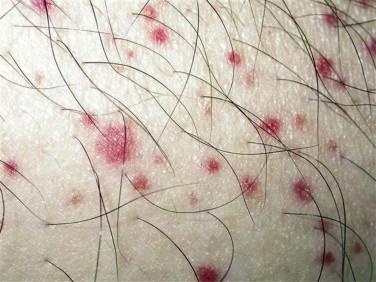
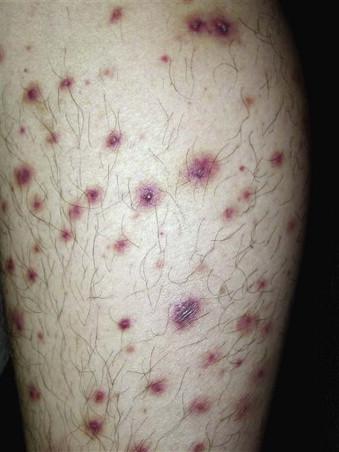
The pathologic findings include small vessel neutrophilic vasculitis affecting the superficial dermal plexus. Fragmented nuclei (karyorrhectic debris) around small vessels are characteristic. Focal intravascular fibrin is commonly seen (see Figs. 4-4 and 4-5 ).
Direct immunofluorescence examination shows both complement and immunoglobulins in vessel walls (see Fig. 4-7 ).
About 10% of all cases of cutaneous vasculitis represent HSP, which is the most common vasculitis in children (~90% all cases). A preceding upper respiratory tract infection occurs in up to 50%, and a history of recent drug or food ingestion triggers is reported in a minority. The classical clinical presentation of Henoch-Schoenlein purpura (HSP) includes the tetrad of skin involvement, arthritis, gastrointestinal (GI) involvement (pain, hemorrhage), and nephritis (found less frequently). Retiform or patterned purpura is considered specific to HSP. Features with high sensitivity and specificity for the diagnosis of HSP are isolated or predominant IgA vascular deposits and two or more of these clinical features: age 20 years or younger, GI involvement (colicky pain or hematochezia), upper respiratory tract infection prodrome, or hematuria or renal biopsy showing mesangioproliferative glomerulonephritis with or without IgA deposits. Long-term follow-up is important; renal impairment can be seen many years after the initial diagnosis (fewer than 20% of children develop chronic renal failure 20 years after diagnosis). Nephrotic syndrome, hypertension, and renal failure at onset are associated with a poor outcome, and in adult patients, those who present with fever, purpura above the waist, and elevated ESR are significantly more likely to have IgA glomerulonephritis.
Skin biopsy in patients with HSP/IgA vasculitis (IgAV) demonstrates neutrophilic small vessel vasculitis (SVV) restricted to the superficial dermis; usually the vascular damage induced is mild, but rarely the whole dermis may be involved. In a retrospective study of cases with HSP/IgAV, tissue eosinophilia correlated with renal involvement in which patients older than the of age 40 years and found to have absent eosinophils on histologic examination of skin tissue were found to have a threefold increased risk of renal involvement compared with those younger than age 40 years with tissue eosinophilia.
Direct immunofluorescence shows isolated or predominant IgA deposits in both involved and uninvolved vessels from lesions less than 48 hours old.
Approximately 20% of cases of cutaneous vasculitis represent an adverse drug eruption and most will represent so-called hypersensitivity vasculitis (CLA) and exhibit a superficial dermal small vessel neutrophilic vasculitis (see Fig. 4-3 ). Therapeutic agents from virtually every pharmacologic class have been implicated in the development of drug-induced vasculitis. The drugs most frequently associated with vasculitis are propylthiouracil, hydralazine, colony-stimulating factors, allopurinol, cefaclor, minocycline, d -penicillamine, phenytoin, isotretinoin, and methotrexate.
Manifestations of drug-induced vasculitis range from CLA to small vessel lymphocytic vasculitis to distinct vasculitic syndromes such as GPA, MPA, EGPA, and PAN. Affected individuals may present with cutaneous involvement alone or life-threatening systemic involvement, which may result in severe and sometimes fatal illness. There are no significant differences in clinical presentation, serologic abnormalities, and pathologic findings compared with idiopathic vasculitides. The interval between the first exposure and appearance of symptoms for drug-induced vasculitis can be extremely variable (i.e., hours to years), with the vasculitis commencing after drug dosage increases and after rechallenge. Death has occurred in 10% of all published cases of drug-induced vasculitis, predominantly in patients with multiple organ involvement. Identifying the offending drug is the most important aspect of treatment because its discontinuation is followed by a rapid improvement of the vasculitis in many cases. Tissue eosinophilia is a histologic clue to a drug etiology.
One of the interestingly more recently recognized agents inducing vasculitis is levamisole. Levamisole was originally introduced as an anthelmintic agent and later used in Behçet disease for immunosuppression, but because of its side effects, it has been withdrawn. More recently, levamisole has been added to cocaine to potentiate the stimulant effects. Affected patients had constitutional symptoms, arthralgia, leukopenia, agranulocytosis, and cutaneous vasculitis with purpuric lesions of the ears, nose, cheeks, and extremities. The lesions have bright-red borders with central necrosis ( Fig. 4-10 ). Despite the severe and dramatic clinical appearance of these lesions, they usually resolve spontaneously within a few weeks of drug discontinuation but can recur with subsequent contaminated cocaine abuse.
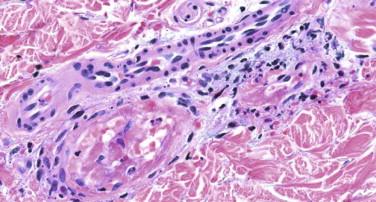
Typically, H&E sections reveal leukocytoclastic vasculitis with variable degrees of vascular damage. It is often mild but may be severe with fibrinoid necrosis of vessel walls. Tissue eosinophilia is common and is a helpful clue. Drug-induced vasculitis may on occasion show features of a lymphocytic or granulomatous vasculitis with a predominant infiltrate of lymphocytes or histiocytes, respectively. A histologic clue to a drug reaction may be the presence of additional inflammatory reaction pattern (e.g., spongiotic interface dermatitis coexisting with vasculitis).
Become a Clinical Tree membership for Full access and enjoy Unlimited articles
If you are a member. Log in here